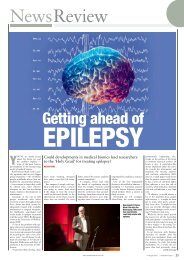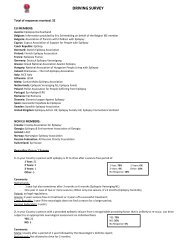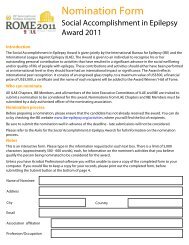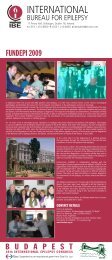Epilepsy and the Workplace: A guide for workers ... - Epilepsy Australia
Epilepsy and the Workplace: A guide for workers ... - Epilepsy Australia
Epilepsy and the Workplace: A guide for workers ... - Epilepsy Australia
You also want an ePaper? Increase the reach of your titles
YUMPU automatically turns print PDFs into web optimized ePapers that Google loves.
<strong>Epilepsy</strong> <strong>and</strong> <strong>the</strong> <strong>Workplace</strong>:A <strong>guide</strong> <strong>for</strong> <strong>workers</strong> <strong>and</strong> employersAn OverviewWritten by Caitlin BaillieA paper from <strong>the</strong> ANU College of Law Internship Program.Edited by Kerie NewellThis is a Guide only <strong>and</strong> does not constitute Legal AdviceWritten under <strong>the</strong> supervision of Jacinta Cummins <strong>and</strong> Cesira CostelloThe <strong>Epilepsy</strong> Association of <strong>the</strong> ACT Inc. March 2011
WITH THANKS TOPETER FORDANDOTHERS© <strong>Epilepsy</strong> ACTCanberra 2011
The purpose of this <strong>guide</strong>The ability to engage in employment allows people to lead fulfilled <strong>and</strong>independent lives. Participation in <strong>the</strong> workplace not only creates financialindependence <strong>and</strong> security, it promotes social inclusion, self-esteem <strong>and</strong>individual productivity. Un<strong>for</strong>tunately, getting into <strong>and</strong> staying in <strong>the</strong> work<strong>for</strong>ceis not always easy <strong>and</strong> <strong>for</strong> people with epilepsy barriers continue to make itdifficult to obtain, <strong>and</strong> hold on to a job. Recent studies have suggested that only30 per cent of adults with epilepsy are in full time employment, with anadditional 17 per cent employed part-time. 1One of <strong>the</strong>se barriers is a lack of in<strong>for</strong>mation <strong>and</strong> underst<strong>and</strong>ing. Surveysindicate that employers <strong>and</strong> co-<strong>workers</strong> have little underst<strong>and</strong>ing of epilepsy <strong>and</strong>express attitudes of anxiety towards epilepsy in <strong>the</strong> workplace. 2 Additionally,while most people with epilepsy have a good underst<strong>and</strong>ing of how to manage<strong>the</strong>ir own condition, <strong>the</strong>y have significantly less underst<strong>and</strong>ing of <strong>the</strong> safety <strong>and</strong>legal issues relating to working with epilepsy. 3This <strong>guide</strong> aims to provide an easy to read introduction to <strong>the</strong> legal issuesrelating to epilepsy <strong>and</strong> employment. It includes in<strong>for</strong>mation <strong>for</strong> <strong>workers</strong> wi<strong>the</strong>pilepsy <strong>and</strong> employers on <strong>the</strong>ir rights <strong>and</strong> responsibilities in <strong>the</strong> workplace. Italso explains <strong>the</strong> legal options available <strong>for</strong> people with epilepsy who feel <strong>the</strong>yhave been unfairly treated in employment matters. The <strong>guide</strong> focuses on twomain areas of <strong>the</strong> law – workplace <strong>and</strong> anti-discrimination law. It <strong>the</strong>n brieflydiscusses <strong>the</strong> emerging field of human rights law <strong>and</strong> <strong>the</strong> rights relevant to <strong>the</strong>workplace. In most of <strong>the</strong>se areas <strong>the</strong> laws discussed apply throughout all of<strong>Australia</strong>. However, state <strong>and</strong> territory laws often operate concurrently <strong>and</strong> <strong>the</strong>semay create additional legal rights <strong>and</strong> responsibilities. Also <strong>the</strong>se different areasof law often overlap <strong>and</strong> interact with each o<strong>the</strong>r.While this manual focuses on legal rights <strong>and</strong> remedies, this is not to suggest<strong>the</strong>se are <strong>the</strong> only paths available to <strong>workers</strong> <strong>and</strong> employers dealing wi<strong>the</strong>pilepsy in <strong>the</strong> workplace. However, an underst<strong>and</strong>ing of legal rights <strong>and</strong>responsibilities encourages a more in<strong>for</strong>med <strong>and</strong> fair workplace.1 . K Brown, ‘The Hidden Stigmas of Chronic Illness’ (2007) Centre <strong>for</strong> Citizenship <strong>and</strong> Human Rights,Occasional paper No 79.2 . C Harden, A Kossay, S Vera <strong>and</strong> B Nikolov, ‘Reactions to <strong>Epilepsy</strong> in <strong>the</strong> <strong>Workplace</strong>’ (2004) 45Epilepsia 1134.3 . M Coker, S Bhargava, M Fitzgerald <strong>and</strong> C Doherty, ‘What do People with Epilepy Know About TheirCondition?’ (2010) Seizure 1.3
Finally, this <strong>guide</strong> is not legal advice. Please see <strong>the</strong> fur<strong>the</strong>r references section at<strong>the</strong> end of <strong>the</strong> paper <strong>for</strong> in<strong>for</strong>mation <strong>for</strong> some places to go if you are facing legalproblems in <strong>the</strong> workplace.The Big Question: Do employees have to disclose <strong>the</strong>irepilepsy?There is no law that requires a worker to tell <strong>the</strong>ir employers or co-<strong>workers</strong>about <strong>the</strong>ir epilepsy. The decision of when <strong>and</strong> how to disclose a medicalcondition is often a very personal one. It involves balancing considerations ofsafety, privacy, honesty <strong>and</strong> <strong>the</strong> potential <strong>for</strong> unfair treatment. Disclosingepilepsy at an early stage increases <strong>the</strong> risk that a person will not be considered‘fit’ <strong>for</strong> a job, but disclosing much later or never at all can cause great personalstress <strong>and</strong> increase <strong>the</strong> risk of seizures.Some specific positions will require a worker to disclose <strong>the</strong>ir medicalconditions. Some jobs require <strong>workers</strong> to undertake a health <strong>and</strong> fitness checkbe<strong>for</strong>e <strong>the</strong>y commence work, or to fill out medical history <strong>for</strong>ms. These arenormally jobs where it is a genuine requirement of <strong>the</strong> work that <strong>the</strong> employeebe physically fit. These medical <strong>for</strong>ms are legal documents <strong>and</strong> must be filledout to <strong>the</strong> best of a worker’s knowledge. In <strong>the</strong>se circumstances, a failure todisclose epilepsy can be a legitimate reason <strong>for</strong> dismissal.If a worker does choose to voluntarily disclose <strong>the</strong>ir epilepsy <strong>the</strong> employer islegally required to keep that in<strong>for</strong>mation confidential <strong>and</strong> not disclose thatin<strong>for</strong>mation to anyone else without <strong>the</strong> worker’s express permission. However,with <strong>the</strong> agreement of <strong>the</strong> worker, it is often good policy to ensure that directsupervisors are aware of any safety issues or extra accommodations a workerwith epilepsy may require. Although a person’s health is a private issue ifpeople in <strong>the</strong> workplace are com<strong>for</strong>table <strong>and</strong> aware of someone’s epilepsy <strong>the</strong>risks posed by any unexpected seizures are decreased.4
<strong>Workplace</strong> LawIntroduction<strong>Workplace</strong> law is used in this <strong>guide</strong> as a broad term to describe <strong>the</strong> laws thatregulate behaviour in <strong>the</strong> workplace. It primarily applies only to people who arealready employed <strong>and</strong> can include rights <strong>and</strong> obligations relating to leaveentitlements, wages, employment security <strong>and</strong> health <strong>and</strong> safety st<strong>and</strong>ards. Thissection of <strong>the</strong> <strong>guide</strong> firstly looks to <strong>the</strong> rights <strong>and</strong> obligations contained in <strong>the</strong>Fair Work Act 2009 (FWA). For <strong>the</strong> purposes of this <strong>guide</strong> <strong>the</strong> relevant parts of<strong>the</strong> FWA relate to <strong>the</strong> right to flexible working agreements <strong>and</strong> limitations ondismissing <strong>workers</strong> or taking o<strong>the</strong>r ‘adverse action’. The second part of thissection looks at occupational health <strong>and</strong> safety (OHS) laws. These are lawsdesigned to create a safe work environment, <strong>and</strong> prevent injuries in <strong>the</strong>workplace. At <strong>the</strong> moment <strong>the</strong>re are no occupational health <strong>and</strong> safety laws thatapply nationally. The ACT Work Safety Act 2008 is discussed as an example ofOHS laws <strong>and</strong> <strong>the</strong> obligations <strong>the</strong>y put on <strong>workers</strong> <strong>and</strong> employers.The Fair Work Act (FWA)The FWA came into <strong>for</strong>ce at <strong>the</strong> start of 2010, creating a new set of lawsgoverning workplace relations. The FWA creates positive <strong>and</strong> negativeprotections in <strong>the</strong> workplace. That is, it outlines certain actions that employerscannot do to employees, <strong>and</strong> in certain circumstances, creates obligations <strong>for</strong>employers to take particular steps to improve working conditions.Unfair dismissal <strong>and</strong> adverse actionsOne of <strong>the</strong> most important of <strong>the</strong>se ‘negative’ rights found in <strong>the</strong> FWA is <strong>the</strong>protection against unfair dismissal. This means a worker cannot be dismissedfrom <strong>the</strong>ir job in circumstances that are harsh, unjust or unreasonable. 4 Under<strong>the</strong> FWA, dismissal is defined to include where a person feels <strong>for</strong>ced to resign,as well as where someone is fired. Although it can be hard to pinpoint exactlywhat ‘harsh, unjust or unreasonable’ means, 5 <strong>the</strong> FWA sets out certain4 . Fair Work Act 2009 (Cth) section 3855 . See e.g. Bostik (<strong>Australia</strong>) Pty Ltd v Gorgevski (No 1) (1992) 36 FCR 205
considerations that indicate whe<strong>the</strong>r or not a dismissal was fair or just. 6 If anemployer is unable to point to a real, valid reason why a worker should be fired,if <strong>the</strong>y gave very short notice of <strong>the</strong> dismissal or didn’t give <strong>the</strong> worker a chanceto respond to accusations made against <strong>the</strong>m, it would be more likely that <strong>the</strong>worker was unfairly fired. This can be a very important protection <strong>for</strong> peoplewith epilepsy. It means that if a worker is dismissed <strong>for</strong> reasons relating to <strong>the</strong>irepilepsy, or misconceptions of it, <strong>and</strong> <strong>the</strong>y are given no chance to discuss itfur<strong>the</strong>r, it would be likely to be deemed unfair dismissal.It means that if <strong>the</strong>y are fired <strong>for</strong> reasons relating to <strong>the</strong>ir epilepsy, <strong>and</strong> not <strong>the</strong>st<strong>and</strong>ard of <strong>the</strong>ir work, it will be unfair under <strong>the</strong> FWA <strong>and</strong> <strong>the</strong>re<strong>for</strong>e unlawful.In addition to a general protection against unfair dismissal, <strong>the</strong> FWA provides<strong>for</strong> some more specific reasons that employees cannot be fired. A key protectionis that an employee cannot be fired because of a temporary absence from workcaused by injury or illness. 7 This means a worker cannot be fired <strong>for</strong> a few daysoff work because of an unexpected seizure or problems with medication.However, it is important to remember that a doctor’s certificate or o<strong>the</strong>r medicalevidence must be produced, o<strong>the</strong>rwise <strong>the</strong> employer can lawfully dismiss <strong>the</strong>worker. 8Un<strong>for</strong>tunately, not all <strong>workers</strong> are protected against unfair dismissal. A personworking <strong>for</strong> a business that employs less than 15 people will not be protectedagainst unfair dismissal until <strong>the</strong>y have been working <strong>the</strong>re <strong>for</strong> at least a year.For all o<strong>the</strong>r businesses <strong>workers</strong> will be protected after six months ofemployment. 9 Also, a worker will not be protected against unfair dismissal if<strong>the</strong>y earn above a high-income threshold. 10 This is currently about $110, 000 peryear. 11If a worker believes <strong>the</strong>y have been unfairly dismissed <strong>the</strong>y can apply to <strong>the</strong> FairWork <strong>Australia</strong> Tribunal. They can seek to get <strong>the</strong>ir job back, or receive6 . Fair Work Act 2009 (Cth) section 3877 . Fair Work Act 2009 (Cth) section 352.8 . Fair Work Regulation 2009 (Cth) regulation 3.019 . Fair Work Act 2009 (Cth) section 38210 . Fair Work Act 2009 (Cth) section 38211 . Note also that an employee will not be protected from unfair dismissal if <strong>the</strong>y are not covered by anaward or an enterprise agreement. Almost all industries have awards that govern pay levels <strong>and</strong> workingconditions. For more in<strong>for</strong>mation go to www.fwa.gov.au .6
compensation <strong>for</strong> <strong>the</strong> loss of <strong>the</strong> job. 12 Importantly, an application to <strong>the</strong>Tribunal must be made within 14 days after being dismissed. 13In addition to <strong>the</strong> unfair dismissal protections, <strong>the</strong> FWA also protects <strong>workers</strong>from o<strong>the</strong>r ‘adverse actions’. Under <strong>the</strong> FWA, an adverse action can includedemoting an employee, refusing to employ a person or discriminating against aworker. 14 The FWA makes it unlawful <strong>for</strong> an employer to take adverse actionagainst an employee <strong>for</strong> exercising <strong>the</strong>ir rights in <strong>the</strong> workplace. 15 Examples of<strong>the</strong>se rights include negotiating workplace agreements, engaging in unionactivities <strong>and</strong> making a complaint against an employer. This means an employercannot disadvantage a worker because <strong>the</strong>y have complained aboutdiscrimination or made a complaint to <strong>the</strong> Fair Work <strong>Australia</strong> Tribunal. This isa very important protection to remember when considering if taking <strong>for</strong>malaction is <strong>the</strong> best option.Terms of employmentNearly all <strong>workers</strong>’ employment is governed by a legal document that sets out<strong>the</strong> terms of employment. For some <strong>workers</strong> this may take <strong>the</strong> <strong>for</strong>m of an award– a general set of conditions that apply to all <strong>workers</strong> with <strong>the</strong> same positions,such as waitresses or boilermakers. Alternatively, o<strong>the</strong>r <strong>workers</strong> may have <strong>the</strong>irworkplace entitlements set by enterprise agreements – agreements that havebeen negotiated <strong>for</strong> that particular workplace or company. Both awards <strong>and</strong>enterprise agreements must be approved by Fair Work <strong>Australia</strong> <strong>and</strong> must meet<strong>the</strong> st<strong>and</strong>ards set out in <strong>the</strong> FWA.It is unlawful <strong>for</strong> an award or enterprise agreement to contain terms that arediscriminatory. 16 This means <strong>the</strong> terms in <strong>the</strong> agreement cannot disadvantage aworker because of characteristics such as age, sex, religion <strong>and</strong> or disability. Asdiscussed in more detail in <strong>the</strong> Discrimination Law section, epilepsy will almostalways be considered a disability <strong>for</strong> legal purposes. This does not mean aperson with epilepsy is any less capable than o<strong>the</strong>r <strong>workers</strong>, but it does make itunlawful <strong>for</strong> a person to be disadvantaged in <strong>the</strong> workplace because of <strong>the</strong>irepilepsy. For examples of <strong>the</strong> kind of conduct that is discriminatory see <strong>the</strong>Discrimination Law section.12 . Fair Work Act 2009 (Cth) section 39013 . Fair Work Act 2009 (Cth) section 390. For more in<strong>for</strong>mation about applying to <strong>the</strong> Tribunal go to <strong>the</strong>Fair Work website www.fwa.gov.au.14 . Fair Work Act 2009 (Cth) section 34215 , Fair Work Act 2009 (Cth) section 34016 . Fair Work Act 2009 (Cth) section 1947
As well as preventing certain terms in awards <strong>and</strong> enterprise agreements, <strong>the</strong>FWA requires <strong>the</strong>m to include a ‘flexibility term’. 17 A flexibility term allows aworker <strong>and</strong> <strong>the</strong>ir employer to agree on non-st<strong>and</strong>ard working conditions where<strong>the</strong> worker has a genuine need. 18 The ability to negotiate working conditionssuch as working hours can be a really effective way to manage a worker’sepilepsy <strong>and</strong> reduce workplace stress associated with epilepsy.The ‘individual flexibility arrangement’ that is negotiated will always bedifferent, depending on <strong>the</strong> nature of <strong>the</strong> workplace, <strong>the</strong> needs of <strong>the</strong> worker <strong>and</strong><strong>the</strong> capacities of <strong>the</strong> employer. However, <strong>the</strong> negotiated arrangement must put<strong>the</strong> worker in a better position than if <strong>the</strong> st<strong>and</strong>ard award or agreement appliedto <strong>the</strong>m. 19 Some examples of flexibility arrangements that may be useful <strong>for</strong>people with epilepsy include:o Consistent work shifts ra<strong>the</strong>r than changing rosters. This can help prevent<strong>the</strong> risk of seizures on <strong>the</strong> job as a lack of sleep can be a seizure trigger.o Different starting <strong>and</strong> finishing times. This can make it easier <strong>for</strong> peoplewith epilepsy who cannot drive to get to work on public transport.o Flexible starting times. This can allow people who have nocturnalseizures to catch up on sleep be<strong>for</strong>e starting work.Again, if a worker feels that <strong>the</strong> terms of <strong>the</strong>ir employment do not include <strong>the</strong>protections of <strong>the</strong> FWA <strong>the</strong>y should make an application to Fair Work <strong>Australia</strong>.Occupational health <strong>and</strong> safetyOccupational health <strong>and</strong> safety laws are vital to ensuring <strong>the</strong> safety <strong>and</strong>wellbeing of all people within <strong>the</strong> workplace. They place an obligation on bo<strong>the</strong>mployers <strong>and</strong> <strong>workers</strong> to protect health <strong>and</strong> safety <strong>and</strong> manage associated risks.OHS laws work best when <strong>workers</strong> <strong>and</strong> employers have a full underst<strong>and</strong>ing of<strong>the</strong> actual nature of <strong>the</strong> risks <strong>and</strong> dangers involved. However, amisunderst<strong>and</strong>ing of <strong>the</strong> risks related to epilepsy can often unnecessarilyexclude <strong>and</strong> isolate <strong>workers</strong>.As mentioned, <strong>the</strong>re are currently no national OHS laws. Ra<strong>the</strong>r each state <strong>and</strong>territory has its own OHS legislation. In addition, <strong>the</strong> CommonwealthOccupational Health <strong>and</strong> Safety Act (1991) applies to all Commonwealth public17 . Fair Work Act 2009 (Cth) section 14418 . Fair Work Act 2009 (Cth) section 14419 . Work Safety Act 2008 (ACT) section 1448
service organisations. As an example of <strong>the</strong> obligations found in OHS laws, <strong>the</strong>ACT Work Safety Act 2008 (WSA) will be discussed in detail. While <strong>the</strong> laws ofo<strong>the</strong>r states <strong>and</strong> territories do take different approaches in <strong>the</strong>ir wording <strong>and</strong>exact nature of <strong>the</strong> legal duties <strong>the</strong>y impose, <strong>the</strong> core ideas of taking action toprotect health <strong>and</strong> safety <strong>and</strong> managing risk in <strong>the</strong> workplace are common to allof <strong>the</strong> Acts. The WSA takes a broad definition of worker to include contractors,volunteers <strong>and</strong> work experience interns as well as employees. 20The WSA contains two key obligations <strong>for</strong> workplace safety. First, an employer,or anyone in control of a workplace, must ensure work safety by managingrisk. 21 This means that an employer must take all reasonable steps to identify <strong>the</strong>risk <strong>and</strong> try to minimise <strong>the</strong> effect of all <strong>the</strong> things that could lead to physical orpsychological injury in <strong>the</strong> workplace. 22The WSA also imposes a duty on <strong>workers</strong>. The WSA places an obligation on<strong>workers</strong> not to expose <strong>the</strong>mselves, or o<strong>the</strong>r people at <strong>the</strong> workplace, to safetyhazards. 23 This means <strong>workers</strong> are obliged to cooperate with reasonableinstructions, use <strong>the</strong> safety equipment provided <strong>and</strong> report any risk of injury orillness <strong>the</strong> worker has identified. 24 It also means taking responsibility <strong>for</strong> yourown safety in <strong>the</strong> workplace.The core idea behind both of <strong>the</strong>se obligations is <strong>the</strong> concept of reasonableness.There will always be some risks that cannot be eliminated, <strong>and</strong> some workplaceswill always be more dangerous that o<strong>the</strong>rs. Deciding what is reasonable in asituation involves balancing a lot of factors, including how dangerous <strong>and</strong> hownecessary an activity is <strong>and</strong> what controls can be put in place. For people wi<strong>the</strong>pilepsy <strong>the</strong> key risk to workplace safety is uncontrolled or breakthroughseizures. However, just how serious this risk is <strong>and</strong> what are reasonable actionsto manage it must always be considered in all <strong>the</strong> circumstances.In thinking about what kind of action is needed to safely manage epilepsy in <strong>the</strong>workplace, <strong>the</strong> first crucial step is to establish <strong>the</strong> nature of a person’s seizures<strong>and</strong> if <strong>the</strong>y are under control. As noted, <strong>for</strong> some people with epilepsy, seizuresmay not take <strong>the</strong> <strong>for</strong>m of convulsions or fits, but can vary from ‘spacing out’ or20 . Work Safety Act 2008 (ACT) section 921 . Work Safety Act 2008 (ACT) section 2122 . A Quick Guide to <strong>the</strong> ACT’s New Work Safety Act 2008, ACT Work Safety Commissioner, 2009http://www.worksafety.act.gov.au/about-new-legislation#Guidance_Material23 . Work Safety Act 2008 (ACT) section 2724 . Work Safety Act 2008 (ACT) section 27(2)9
unconsciously w<strong>and</strong>ering. Approximately 70% of people with epilepsy achieveseizure control with medication <strong>and</strong> o<strong>the</strong>r <strong>workers</strong> with epilepsy may experience‘auras’ or warnings be<strong>for</strong>e a seizure occurs. This gives people a chance toremove <strong>the</strong>mselves from dangerous situations. All <strong>the</strong>se factors significantlyreduce <strong>the</strong> safety risks associated with seizures.O<strong>the</strong>r crucial considerations include:o The nature of <strong>the</strong> work: is it at height, at extreme temperatures or usingdangerous machinery?o The use of protective equipment: will gloves or helmets minimise risk?o Alternative working conditions: can <strong>the</strong> job be done somewhere else, orat a different pace?o Sharing work responsibilities: it is reasonable to use a buddy system?The case study below provides a good example of how <strong>workers</strong> <strong>and</strong> employeesshould be thinking about epilepsy-related workplace safety risks. Although thiscase was decided in relation to discrimination law, it still illustrates importantconsiderations <strong>for</strong> OHS laws.Butcher v The Key King [2000] ACTDT 2In this case, Mr Butcher was employed as a retail assistant in a chain of storesthat provided key cutting, engraving <strong>and</strong> shoe repair services. His job involvedusing dangerous machinery, capable of cutting through human flesh, in aconfined area. At <strong>the</strong> time Mr Butcher was employed he had been diagnosedwith epilepsy <strong>for</strong> about five years, <strong>and</strong> he had suffered about 10 to15 seizures inthis time. The seizures generally lasted <strong>for</strong> about one to five minutes <strong>and</strong> MrButcher was able to identify when he was about have an episode.After about a year of employment, Mr Butcher had a seizure at work. Concernedabout health <strong>and</strong> safety obligations, <strong>the</strong> employer asked Mr Butcher to providemedical evidence about <strong>the</strong> stability of his condition. The doctor who providedthis in<strong>for</strong>mation believed that it was not a safety risk <strong>for</strong> Mr Butcher to workaround machinery as he always got warning of when a seizure was about tooccur <strong>and</strong> was able to move himself into a safe position. The doctor alsorecommended appropriate first aid methods to be employed if Mr Butchersuffered ano<strong>the</strong>r seizure at work.10
In <strong>the</strong> next six months Mr Butcher suffered two more seizures at work. Daysafter this final seizure, his employment was terminated <strong>for</strong> health <strong>and</strong> safetyreasons. There was, however, no suggestion that Mr Butcher would cause injuryto o<strong>the</strong>r <strong>workers</strong>. Mr Butcher claimed <strong>the</strong> decision to fire him wasdiscriminatory <strong>and</strong> made an application to <strong>the</strong> ACT Discrimination Tribunal. 25The Tribunal was quick to note that terminating employment in <strong>the</strong> name ofhealth <strong>and</strong> safety was undermining <strong>the</strong> obligation of protecting <strong>the</strong> safety of thatperson at work. It also found that because Mr Butcher could tell when a seizurewas going to happen he ‘posed no greater danger to himself than would be <strong>the</strong>case if he did not suffer <strong>the</strong> impairment’. There<strong>for</strong>e, <strong>the</strong>re were no legitimateOHS reasons <strong>for</strong> firing Mr Butcher, or o<strong>the</strong>rwise disadvantaging him. Lookingto discrimination law, <strong>the</strong> Tribunal <strong>the</strong>n found Mr Butcher had beendiscriminated against <strong>and</strong> he was awarded damages.While each case will always be different, this demonstrates that employers mustthink seriously about <strong>the</strong> actual risks a seizure on <strong>the</strong> job may pose. The abilityto know when a seizure is coming, to move to a safe place or o<strong>the</strong>rwise controlepisodes, significantly reduces any risks associated with seizures. This can mean<strong>the</strong> protections needed in <strong>the</strong> workplace are not significant.Discrimination LawIntroductionThe Disability Discrimination Act (DDA) provides protection againstdiscrimination <strong>and</strong> unfair treatment <strong>for</strong> people with disabilities. The aim of <strong>the</strong>DDA is to eliminate, as far as possible, discrimination on <strong>the</strong> grounds ofdisability, to ensure people with disabilities have <strong>the</strong> same rights to equalitybe<strong>for</strong>e <strong>the</strong> law as <strong>the</strong> rest of <strong>the</strong> community, <strong>and</strong> to promote recognition <strong>and</strong>acceptance of <strong>the</strong> fundamental rights of people with disabilities. 26 The DDAoperates throughout all of <strong>Australia</strong>, although all states <strong>and</strong> territories have <strong>the</strong>irown laws <strong>and</strong> complaints systems that operate concurrently. Commonweal<strong>the</strong>mployees in <strong>the</strong> AC are covered by <strong>the</strong> DDA (Federal Act). ACT Government<strong>and</strong> private sector employees can avail <strong>the</strong>mselves of both <strong>the</strong> DDA <strong>and</strong> <strong>the</strong>ACT Discrimination Act. The ACT Discrimination Act follows a different25 . This is now part of <strong>the</strong> ACT Civil <strong>and</strong> Administrative Appeals Tribunal (ACAT).26 . Disability Discrimination Act 1991 (Cth) section 311
structure to <strong>the</strong> DDA, applying general discrimination on all grounds, such assex <strong>and</strong> age. However, it uses <strong>the</strong> same legal tests <strong>and</strong> principles as <strong>the</strong> DDAthat are discussed below. The relevant legislation in o<strong>the</strong>r states <strong>and</strong> territoriesinclude <strong>the</strong> Anti-Discrimination Acts of New South Wales, Nor<strong>the</strong>rn Territory,Queensl<strong>and</strong> <strong>and</strong> Tasmania <strong>and</strong> <strong>the</strong> Equal Opportunity Acts of Victoria, South<strong>Australia</strong> <strong>and</strong> Western <strong>Australia</strong>. While all <strong>the</strong>se Acts protect againstdiscrimination in <strong>the</strong> workplace, <strong>the</strong>y use different language <strong>and</strong> slightlydifferent legal tests may apply.The DDA makes it unlawful <strong>for</strong> employers to discriminate against peoplebecause of <strong>the</strong>ir disability. It also places obligations on employers to makereasonable adjustments to <strong>the</strong> working environment or practices toaccommodate <strong>the</strong> needs of people with disabilities. As well as adding to aculture of anti-discrimination, <strong>the</strong> DDA creates a complaint-based mechanism,where persons who believe <strong>the</strong>y have been unfairly treated may seek remediesincluding compensation <strong>and</strong> re-instatement. The meanings of ‘disability’ <strong>and</strong>‘discrimination’, <strong>the</strong> obligations of employers <strong>and</strong> <strong>the</strong> remedies available under<strong>the</strong> DDA will be explored in more detail below.It is also important to note that <strong>the</strong> DDA extends protection to a broad range ofemployment arrangements. As well as applying to full-time <strong>workers</strong>, it protectscasual <strong>and</strong> part-time employees <strong>and</strong> independent contractors. 27 The ACTDiscrimination Act also extends protection to people working in partnerships oras commission agents. 28Defining disabilityThe DDA offers protection against discrimination <strong>for</strong> people with disability. It isimportant to remember not all people with epilepsy will consider <strong>the</strong>mselves asdisabled or affected by a disability. In fact, <strong>the</strong> language of ‘disability’ can oftenencourage stereotyped <strong>and</strong> misin<strong>for</strong>med attitudes towards people with epilepsy<strong>and</strong> o<strong>the</strong>r conditions. A reluctance to be identified as ‘disabled’ can mean thatmany people with epilepsy may not feel <strong>the</strong>y are protected by, or want to relyon, disability discrimination laws. However, <strong>the</strong> DDA uses a broad definition ofdisability to give important protections to many people who may not consider<strong>the</strong>mselves ‘disabled’.27 . Disability Discrimination Act 1991 (Cth) section 428 . Disability Discrimination Act 1991 (Cth) sections 12 <strong>and</strong> 1412
The Act does not specifically refer to epilepsy, but uses a general <strong>and</strong> broaddefinition of disability which includes:o total or partial loss of a person’s bodily or mental functionso <strong>the</strong> presence in <strong>the</strong> body of organisms causing, or capable of causing,disease or illnesso <strong>the</strong> malfunction, mal<strong>for</strong>mation or disfigurement of part of a person’sbodyo a disorder that results in a person learning differently from peoplewithout <strong>the</strong> disordero a disorder, illness or disease that affects a person’s thought processes,perception of reality, emotions or judgment that results in disturbedbehaviour. 29The list refers to disorders or conditions that currently exist, have previouslyexisted, or may exist in <strong>the</strong> future. This can include a genetic predisposition to acertain condition, such as epilepsy.The definition also includes a disorder or condition that is attributed to a person.That means <strong>the</strong> definition of disability includes conditions that o<strong>the</strong>r peopleperceive a person to have, even if this is not <strong>the</strong> case. If a person has receivedunfair treatment based on an employer’s or co-worker’s assumption that <strong>the</strong>ysuffer from an illness, this will be treated as a disability <strong>for</strong> <strong>the</strong> purposes of <strong>the</strong>DDA even if <strong>the</strong> person does not have <strong>the</strong> illness. In <strong>the</strong> case of epilepsy, if anemployer mistakenly assumes a worker suffers from uncontrolled seizures, <strong>the</strong>seizures will be treated as a disability even if <strong>the</strong> worker has not actually hadone <strong>for</strong> years.When considering if a person’s physical or mental state can be regarded as adisability <strong>for</strong> <strong>the</strong> purposes <strong>the</strong> DDA, <strong>the</strong> associated symptoms <strong>and</strong> secondaryeffects of <strong>the</strong> condition must also be considered. This can include <strong>the</strong> affect ofmedication <strong>and</strong> symptoms that change from time to time. 30Given this broad <strong>and</strong> flexible definition, almost all <strong>for</strong>ms of epilepsy are likelyto be considered a disability under <strong>the</strong> DDA, <strong>and</strong> past cases have accepted this. 3129 . Disability Discrimination Act 1991 (Cth) section 430 . Purvis v State of NSW (2003) 217 CLR 92.31 . Rawcliffe v Nor<strong>the</strong>rn Sydney Central Coast Area Health Service [2007] FMCA 931, Stevens vQueensl<strong>and</strong> Police Service [1998] QADT 613
Defining discriminationThe DDA makes it unlawful <strong>for</strong> an employer to discriminate against a personbecause of <strong>the</strong>ir disability in relation to offers of employment, terms <strong>and</strong>conditions in <strong>the</strong> workplace, opportunities <strong>for</strong> promotion <strong>and</strong> dismissal. Tomake clear exactly what kind of behaviour is unlawful, <strong>the</strong> DDA defines twotypes of discrimination: direct <strong>and</strong> indirect. Direct discrimination is where aperson is treated less favourably because of <strong>the</strong>ir disability. 32 This includes <strong>the</strong>more clear-cut examples of discrimination such as failing to offer someone aposition, excluding a person from workplace activities or giving someone lessrostered shifts because of a person’s epilepsy.The definition of direct discrimination also imposes direct obligations onemployers to make reasonable adjustments to accommodate a worker’sdisability. If <strong>the</strong> worker is treated less favourably because of <strong>the</strong> failure toaccommodate, it will be discrimination. 33 An example of <strong>the</strong> kind of situationthis is meant to cover may be where a person works in a carer position withresponsibility, such as a nurse, but has recently had problems with uncontrolledseizures. Under direct discrimination it would be unlawful to prevent this personfrom working in a position of responsibility where reasonable adjustments, suchas ensuring <strong>the</strong>y are rostered on with at least one o<strong>the</strong>r person, could easily bemade to minimise <strong>the</strong> risk.There are limits to what kind of adjustments an employer is required to make.First, <strong>the</strong>y must be reasonable – <strong>the</strong>y must fit with <strong>the</strong> nature of <strong>the</strong> work, <strong>the</strong>resources of <strong>the</strong> employer <strong>and</strong> <strong>the</strong> requirements of o<strong>the</strong>r <strong>workers</strong>. Also, anemployer is only required to make reasonable adjustments to accommodate aperson’s disability where this would not cause unjustifiable hardship. Factorssuch as <strong>the</strong> detriment <strong>the</strong> employee suffers without <strong>the</strong> adjustments, <strong>the</strong> size of<strong>the</strong> business <strong>and</strong> <strong>the</strong> nature of <strong>the</strong> adjustment will be considered in determiningwhe<strong>the</strong>r not making adjustments would cause an employer hardship.The DDA also recognises discrimination is not always clear cut or alwaystargeted at an individual. Ra<strong>the</strong>r, certain workplaces may have requirements orconditions in place that make it harder <strong>for</strong> people with epilepsy to gainemployment or be eligible <strong>for</strong> transfers or promotion. This is known as indirectdiscrimination. Under <strong>the</strong> DDA it is unlawful <strong>for</strong> an employer to make32 . Disability Discrimination Act 1991 (Cth) section 533 . Disability Discrimination Act 1991 (Cth) section 5(2)14
compulsory certain requirements or conditions, that a person with disabilitycannot comply with because of <strong>the</strong>ir disability. 34 That is, it is indirectdiscrimination where treating all <strong>workers</strong> identically results in unfairness topeople who have different needs to o<strong>the</strong>r <strong>workers</strong>.Again, what is a discriminatory condition is subject to whe<strong>the</strong>r <strong>the</strong> requirementis reasonable. An example of this is where an employer makes it a condition ofoperating certain machinery that a worker is not taking any medication. Thisrequirement would be discriminatory as it prevents a whole range of people withmedical conditions per<strong>for</strong>ming certain types of work. However, if <strong>the</strong> machinerywas dangerous, <strong>the</strong> employer does have to think about health <strong>and</strong> safetyconsiderations. So if concentration <strong>and</strong> attention is needed to operate <strong>the</strong>machinery safely, it would be a reasonable requirement that no person can use<strong>the</strong> machine who is taking medication that makes <strong>the</strong>m drowsy or affects <strong>the</strong>irconcentration.When thinking about whe<strong>the</strong>r an act does amount to discrimination, it isimportant to think about <strong>the</strong> genuine requirements of <strong>the</strong> job. It will not bediscrimination if an employer prevents a person per<strong>for</strong>ming certain work if <strong>the</strong>irdisability means that <strong>the</strong>y cannot per<strong>for</strong>m <strong>the</strong> key requirements of <strong>the</strong> job.Courts have held that a genuine requirement <strong>for</strong> a job is not just limited to <strong>the</strong>physical or mental capacity to per<strong>for</strong>m a certain task, but it also includes beingable to work in a way that does not pose any health <strong>and</strong> safety risks <strong>for</strong> o<strong>the</strong>r<strong>workers</strong>. 35For example, if a person was prohibited from driving because of <strong>the</strong>ir seizures,it would not be discrimination to prevent <strong>the</strong>m from working as a courier or taxidriver. However, <strong>for</strong> jobs where driving is a small component, employers shouldthink very carefully about whe<strong>the</strong>r <strong>the</strong> ability to drive is a genuine requirementor whe<strong>the</strong>r alternatives such as taxis or public transport can be effectively used.To put some of this law into perspective, <strong>the</strong> case study below looks at a realexample of discrimination in <strong>the</strong> workplace.34 . Disability Discrimination Act 1991 (Cth) section 635 . X v Commonwealth (1999) 200 CLR 11715
Rawcliffe v Nor<strong>the</strong>rn Sydney Central Coast Area Health Service [2007]FMCA 931In this case Mr Rawcliffe was a nurse working in <strong>the</strong> psychiatric ward of ahospital. It was accepted that Mr Rawcliffe had post-traumatic epilepsy, <strong>and</strong> at<strong>the</strong> time of <strong>the</strong> claimed discrimination he had recently had a seizure <strong>and</strong> hismedication was causing sleep difficulties. The hospital management <strong>and</strong> MrRawcliffe’s supervisors were at all times aware of his medical condition <strong>and</strong>current symptoms. Mr Rawcliffe made a complaint to <strong>the</strong> <strong>Australia</strong>n HumanRights Commission, claiming he had been discriminated against in <strong>the</strong>workplace on at least two separate occasions, <strong>the</strong> stress of which caused him toresign. This was not resolved at <strong>the</strong> Commission level <strong>and</strong> was taken to <strong>the</strong>Federal Magistrates Court.The court examined two claims of discrimination. The first involved <strong>the</strong>structure of Mr Rawcliffe’s work roster, requiring him to work a day shift inbetween two night shifts. Because of sleep difficulties caused by his newepilepsy medication, Mr Rawcliffe had requested regular shifts that would allowhim to maintain a sleeping routine. The Court accepted Mr Rawcliffe’s request<strong>for</strong> regular shifts was reasonable <strong>and</strong> that having to comply with switching fromday to night shifts would cause Mr Rawcliffe serious disadvantage. This meantthat Mr Rawcliffe has been indirectly discriminated against because <strong>the</strong> hospitalimposed working conditions that, because of his epilepsy, he was not able tocomply with <strong>and</strong> which were not reasonable in <strong>the</strong> circumstances.The second claim of discrimination involved a requirement to attend workplacecounselling because of behaviour in a training session. Mr Rawcliffe did notreceive notice of <strong>the</strong> counselling session until a day or two be<strong>for</strong>e he wasrequired to attend, while ano<strong>the</strong>r colleague who was required to attend wasgiven 14 days notice. Mr Rawcliffe claimed <strong>the</strong> lack of notice wasdiscriminatory because it caused him more stress than a person in his positionwithout epilepsy. The Court found that <strong>the</strong> difference in notice times wasbecause of <strong>the</strong> different times <strong>the</strong> two nurses would be in <strong>the</strong> hospital. It was notdirect discrimination because Mr Rawcliffe was not treated less favourablybecause of his epilepsy. It was not indirect discrimination because Mr Rawcliffecould in fact comply with <strong>the</strong> short notice, <strong>and</strong> <strong>the</strong>re was no evidence he would16
from an apology, to being reinstated to a job or given new, improved workingconditions.Even though <strong>the</strong> conference is intended to be in<strong>for</strong>mal, it can still be a difficultprocess <strong>for</strong> both <strong>the</strong> worker <strong>and</strong> employer to go through. It involves having to sit<strong>and</strong> talk to <strong>the</strong> person you are in a dispute with <strong>and</strong> <strong>the</strong> conference will onlywork if both parties want to genuinely listen to each o<strong>the</strong>r <strong>and</strong> try find asolution.If no adequate resolution is reached at conciliation stage, <strong>the</strong> matter can bereferred to ano<strong>the</strong>r Tribunal, such as <strong>the</strong> Fair Work <strong>Australia</strong> Tribunal, or it canbe terminated. 38 If it is terminated, any person affected by <strong>the</strong> complaint has <strong>the</strong>right to lodge an application to <strong>the</strong> Federal Court or <strong>the</strong> Federal MagistratesCourt. An appeal be<strong>for</strong>e a Federal Court is a much more <strong>for</strong>mal matter. Thereare application fees involved, legal representatives may be required, which alsoincreases costs, <strong>and</strong> unsuccessful parties may be ordered to pay <strong>the</strong> costs of <strong>the</strong>o<strong>the</strong>r party. At this stage <strong>the</strong> complaint will be a public matter. The stress <strong>and</strong>costs of legal proceedings are likely to be important considerations indetermining how far a worker wants to take <strong>the</strong>ir complaint, <strong>and</strong> how far anemployer wants to defend <strong>the</strong>ir actions.The court will look at <strong>the</strong> discrimination complaint according to <strong>the</strong> legalprovisions of <strong>the</strong> DDA. It will make a binding order determining ifdiscrimination has or has not occurred. If discrimination is found, <strong>the</strong> court mayaward compensation payments.The ACT Human Rights CommissionWorkers in <strong>the</strong> ACT, who are not employed by Commonwealth departments,can also make complaints of discrimination to <strong>the</strong> ACT Human RightsCommission (ACT HRC). The complaint will be h<strong>and</strong>led by <strong>the</strong> ACT HumanRights <strong>and</strong> Discrimination Commissioner.The ACT Human Rights Commission operates a similar conciliation-basedmodel to <strong>the</strong> AHRC, but if conciliation fails at <strong>the</strong> ACT HRC, <strong>the</strong> complainanthas <strong>the</strong> option to go to <strong>the</strong> lower-cost ACT Tribunal as opposed to <strong>the</strong>potentially more expensive Federal Court or Magistrate Court. The ACT HumanRights Commission is part of ACT Government <strong>and</strong> is located in Civic.38 . <strong>Australia</strong>n Human Rights Commission Act 1986 (Cth) section 46PH18
The ACT Discrimination Act 1991 covers more attributes than those available at<strong>the</strong> Commonwealth level, <strong>and</strong> also includes <strong>the</strong> ground of disability. Arguably,<strong>the</strong> right to <strong>the</strong> equality provision of <strong>the</strong> ACT Human Rights Act broadens <strong>the</strong>definition of discrimination under <strong>the</strong> ACT Discrimination Act because s.30 of<strong>the</strong> HRA requires that all ACT laws are interpreted consistently with humanrights.Once a complaint is lodged with <strong>the</strong> ACT Human Rights Commission, <strong>the</strong>complainant is barred from lodging a complaint with <strong>the</strong> <strong>Australia</strong>n HumanRights Commission.The case of Butcher v Key King discussed above was decided under <strong>the</strong> ACTDiscrimination Act.The ACT HRC also includes <strong>the</strong> Health Services Commissioner, Disability <strong>and</strong>Community Services Commissioner <strong>and</strong> <strong>the</strong> Children <strong>and</strong> Youth PeopleCommissioner. These Commissioners can take complaints regarding:o a health service in <strong>the</strong> ACT, including about inadequate treatment oraccessing health records;o a service <strong>for</strong> people with disability <strong>and</strong> <strong>the</strong>ir carers;o a service <strong>for</strong> children <strong>and</strong> young people <strong>and</strong> <strong>the</strong>ir carers;o a service <strong>for</strong> older people <strong>and</strong> <strong>the</strong>ir carers.Human Rights ActsHuman rights are <strong>the</strong> rights inherent to all human beings; rights that promote <strong>the</strong>dignity <strong>and</strong> fundamental equality of all humanity. There is currently no nationalhuman rights framework in <strong>Australia</strong>. However, both <strong>the</strong> ACT <strong>and</strong> Victoriahave legislation aimed at promoting <strong>and</strong> protecting human rights. The VictorianCharter of Human Rights <strong>and</strong> Responsibilities (Charter) <strong>and</strong> <strong>the</strong> ACT HumanRights Act (HRA) both contain a list of human rights that all laws in Victoria<strong>and</strong> <strong>the</strong> ACT must not be inconsistent with. One of <strong>the</strong> rights most relevant tofairness in <strong>the</strong> workplace is <strong>the</strong> right to equality be<strong>for</strong>e <strong>the</strong> law <strong>and</strong> freedomfrom discrimination. This rein<strong>for</strong>ces <strong>the</strong> underlying <strong>the</strong>me of all <strong>the</strong> workplaceprotections discussed above: people with epilepsy have <strong>the</strong> exact same rights in<strong>the</strong> workplace as everyone else. The HRA also protects a person’s right to19
privacy. This again emphasises <strong>the</strong> importance of an employer h<strong>and</strong>ling medicalin<strong>for</strong>mation confidentially.While <strong>the</strong> Charter <strong>and</strong> HRA are important tools <strong>for</strong> promoting human rightsvalues, <strong>the</strong>y provide limited protection <strong>for</strong> people who believe that <strong>the</strong>ir rightshave been infringed. However, <strong>the</strong> Charter <strong>and</strong> HRA place a positive duty on allVictorian or ACT Government departments to act consistently with humanrights. 39 In <strong>the</strong> ACT, an employee of a government department who believes<strong>the</strong>ir human rights have been breached may bring an action against <strong>the</strong> employerin <strong>the</strong> ACT Supreme Court. 40 In Victoria, legal action <strong>for</strong> breach of humanrights may only be taken as part of ano<strong>the</strong>r court action. 41 That is, a departmentcannot be taken to court <strong>for</strong> breach of human rights alone. From a practicalperspective, it may be far easier to demonstrate <strong>the</strong> specific provisions of <strong>the</strong>FWA or DDA have been breached than to argue that an employer has infringedyour right to equality.As discussed above, however, <strong>the</strong> right to equality under <strong>the</strong> ACT HRA mayarguably broaden <strong>the</strong> definition of disability under <strong>the</strong> ACT Discrimination Act.39 . Human Rights Act 2004 (ACT) Section 40B, Charter of Human Rights <strong>and</strong> Responsibilities Act 2006(Vic) section 3840 . Human Rights Act 2004 (ACT) section 40C41 . Charter of Human Rights <strong>and</strong> Responsibilities Act 2006 (Vic) section 3920
Fur<strong>the</strong>r referencesIf you feel your workplace rights have been infringed, or <strong>for</strong> more in<strong>for</strong>mationon how to create an epilepsy-friendly workplace <strong>the</strong> following ACT-basedorganisations may be of assistance:<strong>Epilepsy</strong> Association ACT Inc.http://www.epilepsyact.org.auACT Disability, Aged <strong>and</strong> Carer Advocacy Service (ADACAS)http://www.adacas.org.auWelfare Rights <strong>and</strong> Legal Centrehttp://www.welfarerightsact.orgACT Work Safety Commissionerhttp://www.worksafety.act.gov.auACT Human Rights Commissionhttp://www.hrc.act.gov.auDiscrimination Legal ServicePh 6247 2018The following websites also provide useful in<strong>for</strong>mation:<strong>Australia</strong>n Human Rights Commissionhttp://hreoc.gov.auFair Work <strong>Australia</strong>http://www.fwa.gov.au<strong>Epilepsy</strong> <strong>Australia</strong> <strong>and</strong> affiliateswww.epilepsyaustralia.net<strong>Epilepsy</strong> ACTwww.epilepsyact.org.au/<strong>Epilepsy</strong> Association of Tasmaniawww.epilepsytasmania.org.au<strong>Epilepsy</strong> Centre SA/NTwww.epilepsycentre.org.au<strong>Epilepsy</strong> Foundation of Victoriawww.epinet.org.au21
<strong>Epilepsy</strong> Queensl<strong>and</strong>www.epilepsyqueensl<strong>and</strong>.com.auIndependent <strong>Epilepsy</strong> Organisations<strong>Epilepsy</strong> Action <strong>Australia</strong>http://www.epilepsy.org.au/22
AppendixFor easy reference, <strong>the</strong> key legal provisions discussed in this manual areextracted below. For <strong>the</strong> full text of <strong>the</strong> legislation <strong>and</strong> cases cited please go tohttp://www.austlii.edu.au.Fair Work Act 2009 (Cth)Section 352: Temporary absence--illness or injuryAn employer must not dismiss an employee because <strong>the</strong> employee is temporarily absentfrom work because of illness or injury of a kind prescribed by <strong>the</strong> regulations.Section 385: What is an unfair dismissalA person has been unfairly dismissed if FWA is satisfied that:(a) <strong>the</strong> person has been dismissed; <strong>and</strong>(b) <strong>the</strong> dismissal was harsh, unjust or unreasonable; <strong>and</strong>(c) <strong>the</strong> dismissal was not consistent with <strong>the</strong> Small Business Fair Dismissal Code;<strong>and</strong>(d) <strong>the</strong> dismissal was not a case of genuine redundancy.Section 387: Criteria <strong>for</strong> considering harshness etc.In considering whe<strong>the</strong>r it is satisfied that a dismissal was harsh, unjust or unreasonable,FWA must take into account:(a) whe<strong>the</strong>r <strong>the</strong>re was a valid reason <strong>for</strong> <strong>the</strong> dismissal related to <strong>the</strong> person'scapacity or conduct (including its effect on <strong>the</strong> safety <strong>and</strong> welfare of o<strong>the</strong>remployees); <strong>and</strong>(b) whe<strong>the</strong>r <strong>the</strong> person was notified of that reason; <strong>and</strong>(c) whe<strong>the</strong>r <strong>the</strong> person was given an opportunity to respond to any reason related to<strong>the</strong> capacity or conduct of <strong>the</strong> person; <strong>and</strong>(d) any unreasonable refusal by <strong>the</strong> employer to allow <strong>the</strong> person to have a supportperson present to assist at any discussions relating to dismissal; <strong>and</strong>(e) if <strong>the</strong> dismissal related to unsatisfactory per<strong>for</strong>mance by <strong>the</strong> person--whe<strong>the</strong>r <strong>the</strong>person had been warned about that unsatisfactory per<strong>for</strong>mance be<strong>for</strong>e <strong>the</strong>dismissal; <strong>and</strong>(f) <strong>the</strong> degree to which <strong>the</strong> size of <strong>the</strong> employer's enterprise would be likely toimpact on <strong>the</strong> procedures followed in effecting <strong>the</strong> dismissal; <strong>and</strong>(g) <strong>the</strong> degree to which <strong>the</strong> absence of dedicated human resource managementspecialists or expertise in <strong>the</strong> enterprise would be likely to impact on <strong>the</strong>procedures followed in effecting <strong>the</strong> dismissal; <strong>and</strong>(h) any o<strong>the</strong>r matters that FWA considers relevant.Work Safety Act 2008 (ACT)Section 21: Duty—safe conduct of business or undertaking(1) This section applies to a person conducting a business or undertaking.(2) The person has a duty to ensure work safety by managing risk.(3) Without limiting subsection (2), <strong>the</strong> person's duty includes—(a) providing <strong>and</strong> maintaining a safe workplace <strong>and</strong> safe systems of work; <strong>and</strong>(b) providing <strong>and</strong> maintaining plant that is safe <strong>and</strong> without risk to <strong>the</strong> work safetyof <strong>workers</strong> <strong>and</strong> o<strong>the</strong>r people at <strong>the</strong> business or undertaking; <strong>and</strong>(c) ensuring that plant is operated only by <strong>workers</strong> <strong>and</strong> o<strong>the</strong>r people at <strong>the</strong> businessor undertaking who are qualified to operate <strong>the</strong> plant; <strong>and</strong>23
(d) ensuring <strong>the</strong> safe use, h<strong>and</strong>ling, storage <strong>and</strong> transport of substances; <strong>and</strong>(e) providing adequate facilities <strong>for</strong> <strong>the</strong> work safety of <strong>workers</strong> <strong>and</strong> o<strong>the</strong>r people at<strong>the</strong> business or undertaking; <strong>and</strong>(f) monitoring <strong>the</strong> work safety of <strong>workers</strong> at <strong>the</strong> business or undertaking, <strong>and</strong> <strong>the</strong>conditions at <strong>the</strong> workplace, to ensure that work-related illness <strong>and</strong> injury areprevented; <strong>and</strong>(g) keeping <strong>the</strong> in<strong>for</strong>mation <strong>and</strong> records relating to work safety required under thisAct, including incident reports <strong>and</strong> training records, in relation to <strong>the</strong> business orundertaking; <strong>and</strong>(h) providing appropriate in<strong>for</strong>mation, instruction, training or supervision to<strong>workers</strong> <strong>and</strong> o<strong>the</strong>r people at <strong>the</strong> business or undertaking to allow work to becarried out safely; <strong>and</strong>(i) consulting <strong>workers</strong> at <strong>the</strong> business or undertaking on matters that directly affect<strong>the</strong>ir work safety; <strong>and</strong>(j) any o<strong>the</strong>r duty prescribed by regulation.Section 27: Duties—worker(1) A worker has a duty not to expose <strong>the</strong> worker, <strong>and</strong> o<strong>the</strong>r people who may beaffected by <strong>the</strong> worker's work, to work safety risks because of <strong>the</strong> worker'swork.(2) Without limiting subsection (1), <strong>the</strong> worker's duty includes—(a) cooperating with a person conducting <strong>the</strong> business or undertaking <strong>for</strong> which<strong>the</strong> worker works, or a person in control of <strong>the</strong> worker's workplace, to allow<strong>the</strong> person to comply with <strong>the</strong> person's duties under this Act; <strong>and</strong>(b) complying with instructions given by a person conducting <strong>the</strong> business orundertaking <strong>for</strong> which <strong>the</strong> worker works, or a person in control of <strong>the</strong>worker's workplace, in relation to work safety; <strong>and</strong>(c)(d)properly using equipment supplied <strong>for</strong> work safety at <strong>the</strong> workplace; <strong>and</strong>reporting any risk, illness <strong>and</strong> injury, connected with work, that <strong>the</strong> worker isaware of.Disability Discrimination Act 1992 (Cth)Section 5. Direct disability discrimination(1) For <strong>the</strong> purposes of this Act, a person (<strong>the</strong> discriminator ) discriminatesagainst ano<strong>the</strong>r person (<strong>the</strong> aggrieved person ) on <strong>the</strong> ground of adisability of <strong>the</strong> aggrieved person if, because of <strong>the</strong> disability, <strong>the</strong>discriminator treats, or proposes to treat, <strong>the</strong> aggrieved person lessfavourably than <strong>the</strong> discriminator would treat a person without <strong>the</strong> disabilityin circumstances that are not materially different.(2) For <strong>the</strong> purposes of this Act, a person (<strong>the</strong> discriminator ) alsodiscriminates against ano<strong>the</strong>r person (<strong>the</strong> aggrieved person ) on <strong>the</strong>ground of a disability of <strong>the</strong> aggrieved person if:(a) <strong>the</strong> discriminator does not make, or proposes not to make,reasonable adjustments <strong>for</strong> <strong>the</strong> person; <strong>and</strong>(b) <strong>the</strong> failure to make <strong>the</strong> reasonable adjustments has, or would have,<strong>the</strong> effect that <strong>the</strong> aggrieved person is, because of <strong>the</strong> disability,treated less favourably than a person without <strong>the</strong> disability would betreated in circumstances that are not materially different.(3) For <strong>the</strong> purposes of this section, circumstances are not materially differentbecause of <strong>the</strong> fact that, because of <strong>the</strong> disability, <strong>the</strong> aggrieved personrequires adjustments.24
Section 6. Indirect disability discrimination(1) For <strong>the</strong> purposes of this Act, a person (<strong>the</strong> discriminator ) discriminatesagainst ano<strong>the</strong>r person (<strong>the</strong> aggrieved person ) on <strong>the</strong> ground of adisability of <strong>the</strong> aggrieved person if:(a) <strong>the</strong> discriminator requires, or proposes to require, <strong>the</strong> aggrievedperson to comply with a requirement or condition; <strong>and</strong>(b) because of <strong>the</strong> disability, <strong>the</strong> aggrieved person does not or would notcomply, or is not able or would not be able to comply, with <strong>the</strong>requirement or condition; <strong>and</strong>(c) <strong>the</strong> requirement or condition has, or is likely to have, <strong>the</strong> effect ofdisadvantaging persons with <strong>the</strong> disability.(2) For <strong>the</strong> purposes of this Act, a person (<strong>the</strong> discriminator ) alsodiscriminates against ano<strong>the</strong>r person (<strong>the</strong> aggrieved person ) on <strong>the</strong>ground of a disability of <strong>the</strong> aggrieved person if:(a) <strong>the</strong> discriminator requires, or proposes to require, <strong>the</strong> aggrievedperson to comply with a requirement or condition; <strong>and</strong>(b) because of <strong>the</strong> disability, <strong>the</strong> aggrieved person would comply, orwould be able to comply, with <strong>the</strong> requirement or condition only if<strong>the</strong> discriminator made reasonable adjustments <strong>for</strong> <strong>the</strong> person, but<strong>the</strong> discriminator does not do so or proposes not to do so; <strong>and</strong>(c) <strong>the</strong> failure to make reasonable adjustments has, or is likely to have,<strong>the</strong> effect of disadvantaging persons with <strong>the</strong> disability.(3) Subsection (1) or (2) does not apply if <strong>the</strong> requirement or condition isreasonable, having regard to <strong>the</strong> circumstances of <strong>the</strong> case.(4) For <strong>the</strong> purposes of subsection (3), <strong>the</strong> burden of proving that <strong>the</strong>requirement or condition is reasonable, having regard to <strong>the</strong> circumstancesof <strong>the</strong> case, lies on <strong>the</strong> person who requires, or proposes to require, <strong>the</strong>person with <strong>the</strong> disability to comply with <strong>the</strong> requirement or condition.Section 15. Discrimination in employment(1) It is unlawful <strong>for</strong> an employer or a person acting or purporting to act onbehalf of an employer to discriminate against a person on <strong>the</strong> ground of <strong>the</strong>o<strong>the</strong>r person's disability:(a) in <strong>the</strong> arrangements made <strong>for</strong> <strong>the</strong> purpose of determining whoshould be offered employment; or(b) in determining who should be offered employment; or(c) in <strong>the</strong> terms or conditions on which employment is offered.(2) It is unlawful <strong>for</strong> an employer or a person acting or purporting to act onbehalf of an employer to discriminate against an employee on <strong>the</strong> ground of<strong>the</strong> employee's disability:(a) in <strong>the</strong> terms or conditions of employment that <strong>the</strong> employer af<strong>for</strong>ds<strong>the</strong> employee; or(b) by denying <strong>the</strong> employee access, or limiting <strong>the</strong> employee's access,to opportunities <strong>for</strong> promotion, transfer or training, or to any o<strong>the</strong>rbenefits associated with employment; or(c) by dismissing <strong>the</strong> employee; or(d) by subjecting <strong>the</strong> employee to any o<strong>the</strong>r detriment.(3) Nei<strong>the</strong>r paragraph (1)(a) nor (b) renders it unlawful <strong>for</strong> a person todiscriminate against ano<strong>the</strong>r person, on <strong>the</strong> ground of <strong>the</strong> o<strong>the</strong>r person'sdisability, in connection with employment to per<strong>for</strong>m domestic duties on <strong>the</strong>premises on which <strong>the</strong> first-mentioned person resides.25
ACT Discrimination Act 19918 What constitutes discrimination(1) For this Act, a person discriminates against ano<strong>the</strong>r person if—(a) <strong>the</strong> person treats or proposes to treat <strong>the</strong> o<strong>the</strong>r person unfavourablybecause <strong>the</strong> o<strong>the</strong>r person has an attribute referred to in section 7; or(b) <strong>the</strong> person imposes or proposes to impose a condition or requirementthat has, or is likely to have, <strong>the</strong> effect of disadvantaging peoplebecause <strong>the</strong>y have an attribute referred to in section 7.(2) Subsection (1) (b) does not apply to a condition or requirement that isreasonable in <strong>the</strong> circumstances.7 Grounds(1) This Act applies to discrimination on <strong>the</strong> ground of any of <strong>the</strong> followingattributes:(a) sex;(b) sexuality;(c) gender identity;(d) relationship status;(e) status as a parent or carer;(f) pregnancy;(g) breastfeeding;(h) race;(i) religious or political conviction;(j) disability;(k) industrial activity;(l) age;(m) profession, trade, occupation or calling;(n) association (whe<strong>the</strong>r as a relative or o<strong>the</strong>rwise) with a personidentified by reference to an attribute referred to in ano<strong>the</strong>r paragraphof this subsection;(o) spent conviction within <strong>the</strong> meaning of <strong>the</strong> Spent Convictions Act2000.26

















